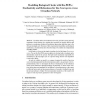Free Online Productivity Tools
i2Speak
i2Symbol
i2OCR
iTex2Img
iWeb2Print
iWeb2Shot
i2Type
iPdf2Split
iPdf2Merge
i2Bopomofo
i2Arabic
i2Style
i2Image
i2PDF
iLatex2Rtf
Sci2ools
CMSB
2009
Springer
2009
Springer
Modelling Biological Clocks with Bio-PEPA: Stochasticity and Robustness for the Neurospora crassa Circadian Network
Circadian clocks are biochemical networks, present in nearly all living organisms, whose function is to regulate the expression of speci’¼üc mRNAs and proteins to synchronise rhythms of metabolism, physiology and behaviour to the 24 hour day/night cycle. Because of their experimental tractability and biological signi’¼ücance, circadian clocks have been the subject of a number of computational modelling studies. In this study we focus on the simple circadian clock of the fungus Neurospora crassa. We use the Bio-PEPA process algebra to develop both a stochastic and a deterministic model of the system. The light on/o’¼Ć mechanism responsible for entrainment to the day/night cycle is expressed using discrete time-dependent events in Bio-PEPA. In order to validate our model, we compare it against the results of previous work which demonstrated that the deterministic model is in agreement with experimental data. Here we investigate the e’¼Ćect of stochasticity on the robustness of the clockŌ...
| Added | 26 May 2010 |
| Updated | 26 May 2010 |
| Type | Conference |
| Year | 2009 |
| Where | CMSB |
| Authors | Ozgur E. Akman, Federica Ciocchetta, Andrea Degasperi, Maria Luisa Guerriero |
Comments (0)

